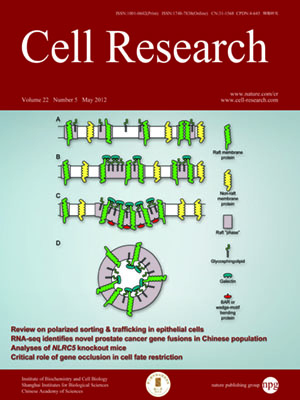
Volume 22, No 5, May 2012
ISSN: 1001-0602
EISSN: 1748-7838 2018
impact factor 17.848*
(Clarivate Analytics, 2019)
Volume 22 Issue 5, May 2012: 859-872
ORIGINAL ARTICLES
A distinct response to endogenous DNA damage in the development of Nbs1-deficient cortical neurons
Rui Li1, Yun-Gui Yang2, Yunzhou Gao1, Zhao-Qi Wang3,4 and Wei-Min Tong1
1Department of Pathology and Center for Experimental Animal Research, Institute of Basic Medical Sciences, Chinese Academy of Medical Sciences & Peking Union Medical College (PUMC), 5 Dong Dan San Tiao, Beijing 100005, China
2Genome Structure & Stability Group, Disease Genomics and Individualized Medicine Laboratory, Beijing Institute of Genomics, Chinese Academy of Sciences, Beijing 100029, China
3Leibniz Institute for Age Research - Fritz Lipmann Institute, Friedrich-Schiller-University Jena, 07745 Jena, Germany
4Faculty of Biology-Pharmacy, Friedrich-Schiller-University Jena, 07745 Jena, Germany
Correspondence: Wei-Min Tong,(wmtong@ibms.pumc.edu.cn)
Microcephaly is a clinical characteristic for human nijmegen breakage syndrome (NBS, mutated in NBS1 gene), a chromosomal instability syndrome. However, the underlying molecular pathogenesis remains elusive. In the present study, we demonstrate that neuronal disruption of NBS (Nbn in mice) causes microcephaly characterized by the reduction of cerebral cortex and corpus callosum, recapitulating neuronal anomalies in human NBS. Nbs1-deficient neocortex shows accumulative endogenous DNA damage and defective activation of Ataxia telangiectasia and Rad3-related (ATR)-Chk1 pathway upon DNA damage. Notably, in contrast to massive apoptotic cell death in Nbs1-deficient cerebella, activation of p53 leads to a defective neuroprogenitor proliferation in neocortex, likely via specific persistent induction of hematopoietic zinc finger (Hzf) that preferentially promotes p53-mediated cell cycle arrest whilst inhibiting apoptosis. Moreover, Trp53 mutations substantially rescue the microcephaly in Nbs1-deficient mice. Thus, the present results reveal the first clue that developing neurons at different regions of brain selectively respond to endogenous DNA damage, and underscore an important role for Nbs1 in neurogenesis.
Cell Research (2012) 22:859-872. doi:10.1038/cr.2012.3; published online 3 January 2012
FULL TEXT | PDF
Browse 2025


